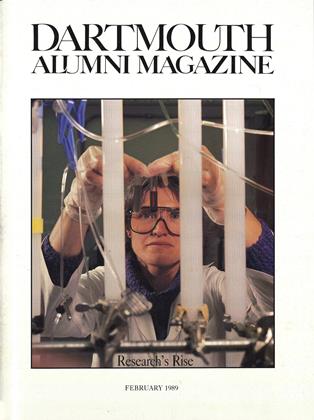The class of 1939, with its 50th Reunion coming in June, found a unique way to combine talent with marketing ingenuity in furthering its Alumni Fund effort. It began when artist Richard L. Brooks '39 offered his considerable talent in the form of a painting of Dartmouth Hall. Based on studies made in Hanover a year ago as a cold front blew through after a snow storm, the finished work was completed last spring in his studio in Essex, Conn.
Then a limited edition of 500 lithographs was struck, each numbered and signed by the artist. In place of a title these reproductions have the four concluding lines of "Dartmouth Undying" under the picture. After the press run the plates were destroyed.
Dick Brooks's original painting will go to the '39er who gives the largest amount (minimum $150,000) to the Reunion Fund. The second largest donor will receivethe Number 1 lithograph, framed and remarqued by the artist with a Dartmouth scene of the donor's choice a remarque being an artist's pencil drawing in the lower left margin of the print. Every other '39er who contributes at least $200 to the Reunion Fund will receive a signed and numberedprint.
Dick Brooks began painting during the summers he was a Dartmouth undergraduate, taking lessons in his native Gloucester, Mass., from impressionist Emile Gruppe, and studying drawing with sculptor George Demetrios of Cape Ann. At College he took every art history course offered and studied with artist-in-residence Paul Sample '20.
Brooksie's prowess in Carnival ice sculpture became a factor in encouraging him to make art his life's work. As a freshman he won the dorm prize for Middle Mass, and then two first prizes for his fraternity. In 1939 he was chosen to do the main Carnival statue, and his 37-foot Eleazar raising a mug became, arguably, the best-known ever. (Brooksie claims President Hopkins filled a few buckets for it on his'travels across campus.)
While serving as executive officer on a DE during the war Brooksie brought out a book of cartoons about a navy recruit called "Elmer Squee." After the war and a short stint at King Features, he originated the widely syndicated strip "The Jackson Twins," which he wrote and drew for 30 years. In 1979 he dropped the strip to return to his first love, painting. Today Brooks's works hang in three museums and last fall his painting of "the lost shipyards" of Middle Haddam, Conn., was unveiled by Governor O'Neill in connection with Connecticut River Shipbuilding Day.
Says Brooks about his new-found success, "It's wonderful to be active and slightly in demand at age 71."
 View Full Issue
View Full Issue
More From This Issue
-
 Cover Story
Cover StoryThe Rise of Research
February 1989 By Anne Bagamery '78 -
 Feature
FeatureGeorge's College
February 1989 By Constance E. Putnam -
 Feature
FeatureA Story of Drama, Fierce Competition, Mom and Apple Pie
February 1989 By George Canizares -
 Article
ArticleREVIEW STUDENTS ARE BACK
February 1989 -
 Class Notes
Class Notes1988
February 1989 By Chuck Young -
 Article
ArticleThe Battle Against AIDS
February 1989 By Martha Hennessey '76








